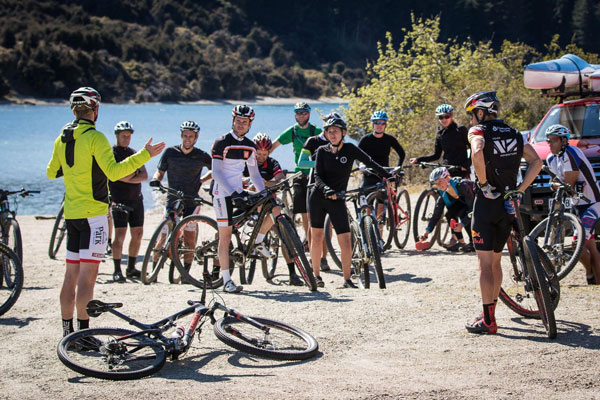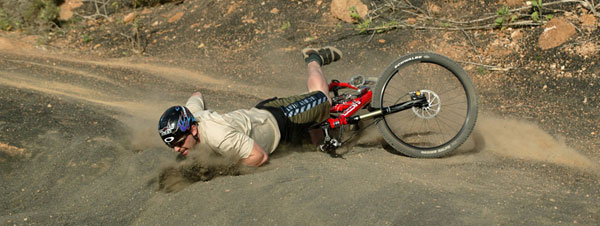Whether you’re a seasoned athlete or a complete novice to mountain biking, it’s a good idea to prepare for the possibility of injury. Mountain biking is an extreme sport made for adrenaline junkies. The nature of mountain biking makes it dangerous. You’re surrounded by a bevy of obstacles while you traverse through a trail at high speeds. Injuries are just a part of the game.
That being said, the sport is fun and great for your health. New bikers shouldn’t avoid the activity for fear of injury. It’s a beneficial activity in all aspects. Not only is it great for your body and health, but the pure fun and excitement of mountain biking make it a popular sport for anyone involved.
While injuries are common, they’re also avoidable. Careless riders are more prone to severe injuries that could have lasting effects. On the other hand, prepared bikers reduce their chances of severe injuries.
Though minor scrapes and bruises are to be expected, avoiding serious injury is easier than you think. Here are 10 ways to avoid injuries while mountain biking.
1. Improve Your Overall Fitness Level
Mountain biking requires a lot of physical fitness that may not be apparent upon your first conquest. With your body in a hunched over position, your back is prone to injury over time. Additionally, your legs, arms, and knees can take a beating. Most riders don’t notice the effects of mountain biking until long after they get off the bike.
Improving your fitness level will give you better control of your bike and reduce the chances of wear and tear on your body. Strength training will help you build muscle. It’s also a good idea to focus on core work. This will help avoid back injuries and improve your riding skills.
2. Stretch and Warm Up
One of the biggest mistakes you can make before riding is failing to warm up. As with all sports, warming up increases the heart rate and prepares the body for a vigorous workout. Failing to do so can lead to more damage and pain after the ride.
Taking ten minutes to stretch beforehand will greatly reduce the chances of injury. Not only that, but continual stretching will improve your flexibility with time. For the best results, perform a full body warm up that incorporates strength and aerobic training.
3. Examine Your Bike
It’s important to examine your bike prior to hitting the trail. Faulty parts can quickly lead to harrowing injuries. Bike examinations should be performed before every riding session. Even the most minute issue can lead to problems on the trail.
Tires pressure and wheels should be inspected closely. Loose sockets and screws can easily pop off during a drop. The frame should also be examined for cracks and splits that could prove to be dangerous. Continual maintenance and examinations on all gear are crucial.
4. Plan For The Ride
 Failure to plan ahead can lead to a host of issues. You should know where the trail will take you and approximately how long it will take to get through. Knowing what types of obstacles lie ahead is also a good idea. This ensures that you’re properly prepared for the ride.
Failure to plan ahead can lead to a host of issues. You should know where the trail will take you and approximately how long it will take to get through. Knowing what types of obstacles lie ahead is also a good idea. This ensures that you’re properly prepared for the ride.
If you don’t plan ahead and are faced with uncertain hurdles, you may find yourself burned out before you finish. This will make you more prone to injury, as you’re not in peak condition to finish the trail.
5. Wear a Helmet
This should be a given, but it’s not uncommon for riders to leave their biking helmet at home. Mountain biking helmets are specially designed to provide you with all of the protection you need. They have carefully placed padding and cushion to shield vulnerable parts of your head.
Serious head injuries from a fall can lead to life-altering injuries or death. It’s important to protect your head throughout the ride. Even if you do fall, your helmet is there to keep you safe.
6. Wear the Right Attire
The right clothes and gear can help you avoid nasty injuries. Body armor is available for mountain biking. It includes guards and cushioning around your legs, arms, and torso. New mountain bikers should invest in body armor to ensure that a fall doesn’t do too much damage.
If full body armor is too much, it’s a good idea to at least wear knee and arm pads. They are lighter and more comfortable to wear. They’ll provide ample protection for vulnerable points on your body during a fall.
7. Stay Hydrated
Water is a crucial part of your body. Depending on where you are riding, you can easily become dehydrated due to heatstroke. Even in cold environments, hydration is important. Dehydration will weaken your body and ultimately cause you to ride carelessly. Drinking a lot of water before you hit the trail is a good start.
During the ride, bladder packs and water reservoirs are essential. With a bladder pack, you can easily sip on water to stay hydrated throughout the trail. Make sure to bring more water than you think you’ll need. This ensures that you are prepared for the unexpected.
8. Learn Proper Body Position
 Mountain bike trails are unlike standard paved trails. They are filled with variable terrain and different levels of elevation. To properly traverse a trail, you need to learn how to position your body. It’s important to move your body weight so that your center of gravity is between the front and rear wheels.
Mountain bike trails are unlike standard paved trails. They are filled with variable terrain and different levels of elevation. To properly traverse a trail, you need to learn how to position your body. It’s important to move your body weight so that your center of gravity is between the front and rear wheels.
You’ll need to continually adjust your position as you go through different parts of the trail. Not only that, but you’ll need to do this while standing on the pedals. This improves your stability greatly, allowing you to maneuver safely.
9. Observe the Trail Ahead
While it may be tempting, never stare at your front wheel while you ride. You must always be alert and observe the trail ahead of you. If you stare at the front wheel, you’re bound to come across a surprise obstacle. Seasoned riders always look ahead by about 50 feet so that they know what is coming.
This is especially important when it comes to drops and jumps. If you’re new to the trail, never take a jump without examining it first. Scoping out the jump will give you a better idea of how to approach it and land safely.
10. Know When To Bail
Taking a tumble is just a part of mountain biking. Even bikers that have been dominating trails for years are bound to wipe out from time to time. It’s important to know when to ditch your bike and jump to safety. If you are approaching an obstacle you know you can’t conquer, it’s a better idea to bail than attempt the feat and experience an injury.
There are a number of techniques that help riders avoid injury. Some involve jumping off to the side while others involve abruptly stopping and maneuvering the bike safely. Understanding these techniques is important, as they can save you from serious injury.



Recent Comments